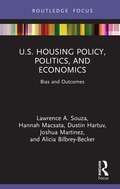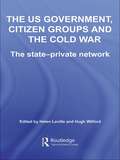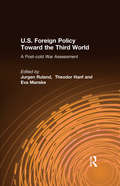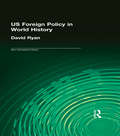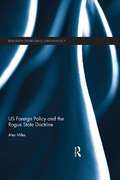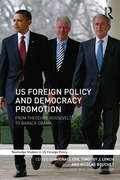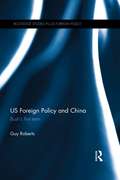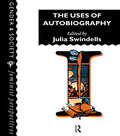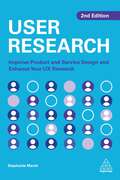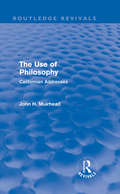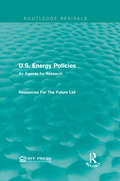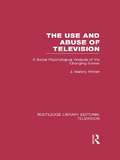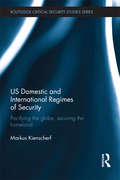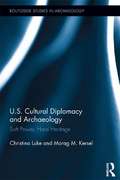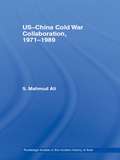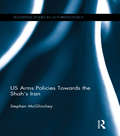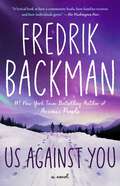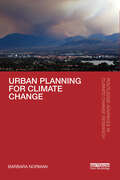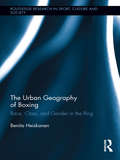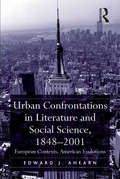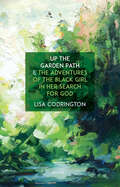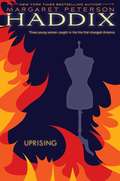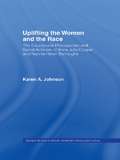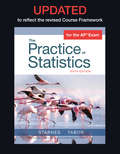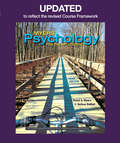Special Collections
Benetech’s Global Certified Accessible Titles
Description: Benetech’s GCA program is the first independent third-party EPUB certification to verify ebook accessibility. By creating content that is born accessible, publishers can meet the needs of all readers. Learn more: https://bornaccessible.benetech.org/
- Table View
- List View
U.S. Housing Policy, Politics, and Economics
by Lawrence A. Souza and Hannah Macsata and Dustin Hartuv and Joshua Martinez and Alicia Bilbrey-BeckerThe stirrings of reform or more of the same? U.S. Housing Policy, Politics, and Economics shares a stark and urgent message. With a new president in the White House and the economy emerging from its peak pandemic lows, the time is right for transformative federal housing legislation—but only if Congress can transcend partisan divides. Drawing on nearly a century of legislative and policy data, this briefing for scholars and professionals quantifies the effects of Democratic or Republican control of the executive and legislative branches on housing prices and policies nationwide. It exposes the lasting consequences of Congress’ more than a decade of failure to pass meaningful housing laws and makes clear just how narrow the current window for action is. Equal parts analysis and call to arms, U.S. Housing Policy, Politics, and Economics is essential reading for everyone who cares about affordable, accessible housing.
The US Government, Citizen Groups and the Cold War
by Hugh Wilford and Helen LavilleThis new book examines the construction, activities and impact of the network of US state and private groups in the Cold War. By moving beyond state-dominated, ‘top-down’ interpretations of international relations and exploring instead the engagement and mobilization of whole societies and cultures, it presents a radical new approach to the study of propaganda and American foreign policy and redefines the relationship between the state and private groups in the pursuit and projection of American foreign relations. In a series of valuable case studies, examining relationships between the state and women’s groups, religious bodies, labour, internationalist groups, intellectuals, media and students, this volume explores the construction of a state-private network not only as a practical method of communication and dissemination of information or propaganda, but also as an ideological construction, drawing upon specifically American ideologies of freedom and voluntarism. The case studies also analyze the power-relationship between the state and private groups, assessing the extent to which the state was in control of the relationship, and the extent to which private organizations exerted their independence. This book will be of great interest to students of Intelligence Studies, Cold War History and IR/security studies in general.
U.S. Foreign Policy Toward the Third World
by Jurgen Ruland and Theodor Hanf and Eva ManskeThe contributors to this work examine the evolution of U.S. foreign policy toward the Third World, and the new policy challenges facing developing nations in the post-Cold War era. The book incorporates the key assessment standards of U.S. foreign policies directed toward critical regions, including Latin America, Africa, the Middle East, Central Asia, and Southeast Asia. Through this region-by-region analysis, readers will get the information and insight needed to fully understand U.S. policy objectives - especially with regard to economic and security issues in the wake of 9/11 - vis a vis the developing world. The book outlines both successes and failures of Washington, as it seeks to deal with the Third World in a new era of terrorism, trade, and democratic enlargement. It also considers whether anti-Western sentiment in Third World regions is a direct result of U.S. foreign policies since the end of the Cold War.
US Foreign Policy in World History
by David RyanUS Foreign Policy in World History is a survey of US foreign relations and its perceived crusade to spread liberty and democracy in the two hundred years since the American Revolution. David Ryan undertakes a systematic and material analysis of US foreign policy, whilst also explaining the policymakers' grand ideas, ideologies and constructs that have shaped US diplomacy.US Foreign Policy explores these arguments by taking a thematic approach structured around central episodes and ideas in the history of US foreign relations and policy making, including:* The Monroe Doctrine, its philisophical goals and impact* Imperialism and expansionism* Decolonization and self-determination* the Cold War* Third World development* the Soviet 'evil empire', the Sandinistas and the 'rogue' regime of Saddam Hussein* the place of goal for economic integration within foreign affairs.
US Foreign Policy and the Rogue State Doctrine
by Alex MilesConcerns over Iran’s nuclear programme, North Korea’s nuclear brinkmanship and, in the past, Iraq’s apparent pursuit of WMD have captured the world’s attention, and dominated the agenda of the American foreign policy establishment. But, what led policymakers and the US military to emphasise the threat of rogue states at the end of the Cold War? Going behind the vivid language of the ‘axis of evil’ and portrayals of undeterrable and reckless rogue states, this work demonstrates how the rogue state doctrine satisfied both domestic and international goals in the Clinton and George W. Bush administrations, underpinning efforts to maintain US leadership and hegemony. It offers a clear picture of the policymaking process, taking a broad, historical approach that places the actions of US officials towards Iraq, Iran, North Korea, Libya and Cuba in a wider context. Through an understanding of the long-standing influences on the US approach we are better able to appreciate why, for instance, regime change dominated the post-9/11 agenda and led to the overthrow of Saddam Hussein. Explaining in detail how the tackling of rogue states became a central aim of US foreign policy, Miles examines whether there was continuity between the Clinton and Bush approach. He moves on to highlight the influence of Congress on the implementation of US policies and the difficulties the US faced in ‘selling’ its approach to allies and adapting its hard-line strategies to reflect developments within the targeted states. By considering the impulses and drivers behind the development of the rogue states approach, this work will extend the scope of existing work in the field and will be of interest to scholars and policymakers alike.
US Foreign Policy and Democracy Promotion
by Michael Cox and Nicolas Bouchet and Timothy J. LynchThe promotion of democracy by the United States became highly controversial during the presidency of George W. Bush. The wars in Iraq and Afghanistan were widely perceived as failed attempts at enforced democratization, sufficient that Barack Obama has felt compelled to downplay the rhetoric of democracy and freedom in his foreign-policy. This collection seeks to establish whether a democracy promotion tradition exists, or ever existed, in US foreign policy, and how far Obama and his predecessors conformed to or repudiated it. For more than a century at least, American presidents have been driven by deep historical and ideological forces to conceive US foreign policy in part through the lens of democracy promotion. Debating how far democratic aspirations have been realized in actual foreign policies, this book draws together concise studies from many of the leading academic experts in the field to evaluate whether or not these efforts were successful in promoting democratization abroad. They clash over whether democracy promotion is an appropriate goal of US foreign policy and whether America has gained anything from it. Offering an important contribution to the field, this work is essential reading for all students and scholars of US foreign policy, American politics and international relations.
US Foreign Policy and China
by Guy RobertsThis work is an exploration of how U.S.-China relations were managed by President George W. Bush. Roberts argues that contrary to conventional wisdom, President Bush conducted a calculated, pragmatic and highly successful strategy toward Beijing, which avoided conflict, resolved crisis and significantly increased economic and diplomatic ties. Roberts identifies key players and polices of the Bush White House and the specific themes of engagement (successful and unsuccessful) that unfolded during Bush’s first term. Research is based on analysis of primary and secondary documentation, as well as interviews with key White House actors (including Deputy Secretary of State Richard Armitage), and two former Australian Prime Ministers. Topics of discussion include China’s changing attitude toward international engagement, China’s rising economic power and the tensions this triggered in the American establishment, the nature of U.S. China relations, contemporary and ideological understanding of the Bush Presidency as well as the strengths and weaknesses of different sources of information. US Foreign Policy and China will be of great interest to students and scholars of US foreign policy and China Studies.
The Uses Of Autobiography
by Julia SwindellsFirst Published in 1995. Routledge is an imprint of Taylor & Francis, an informa company.
User Research
by Stephanie MarshMany businesses are based on creating desirable experiences, products and services for users. However, companies often fail to consider the end user - the consumer - in their planning and development processes. How can marketing practitioners effectively understand their customers and create products and services that work for them? This book has the answers.User experience research, also known as UX research, focuses on understanding user behaviours, needs and motivations through a range of observational techniques, task analysis and other methodologies. User Research is a practical guide that shows readers how to use the vast array of user research methods available. Written by one of the UK's leading UX research professionals, readers can benefit from in-depth knowledge that explores the fundamentals of user research.Covering all the key research methods including face-to-face user testing, card sorting, surveys, A/B testing and many more, the book gives expert insight into the nuances, advantages and disadvantages of each, while also providing guidance on how to interpret, analyze and share the data once it has been obtained. Now in its second edition, User Research provides a new chapter on research operations and infrastructure as well as new material on combining user research methodologies.
The Use of Philosophy
by John H MuirheadFirst published in 1928, this book reproduces the lectures and addresses that John Henry Muirhead gave on various occasions during the two and a half years he spent as Lecturer of Philosophy on the Mills Foundation at the University of California, USA. The different chapters look at the meaning and general place of Philosophy as a subject of study and the application of its leading conceptions to different areas of modern life, including science and politics. The final chapters however, present two short talks of a different nature, which were addressed to Scottish countrymen, gathered on foreign shores. This book outlines Muirhead's philosophical thoughts and conclusions to which he devoted his life.
U.S. Energy Policies
by Resources For The Future LtdU.S. Energy Policies, first published in 1968, aims to assemble and describe within an overall framework the energy policy questions that RRF believed would profit from study and analysis. This study covers the past performance and trends in the energy industries, the nature of existing industries and of the government policies bearing on them, and the effects of those policies. This title also takes note of the prospective influence of economic and technological developments and evaluates the probable effects of selected alternatives to existing policies. This book will be of interest to students of environmental studies.
The Use and Abuse of Television
by J. Mallory WoberA critical review of the harms and benefits of television that also examines systems for maximizing television's benefits. The author breaks away from the conventional jargon of audience measurement and other traditional research methods, proposing instead new and alternative European and Australian methods of evaluating programming. Typical characterizations of the television screen – broadly defined to include television, home video, movies, games, programs and computers – as either the root of all social ills or the potential savior of society are reexamined. Wober's ultimately optimistic viewpoint seeks to trigger change in the way we think about and assess television and in turn ensure that screens will serve, rather than take advantage of, their users. Originally published in 1988, this thinking-piece concerns timeless issues still of import.
US Domestic and International Regimes of Security
by Markus KienscherfThis book maps the increasing convergence of US domestic and international security regimes, analyzing the trend towards global pacification in the name of 'security'. The dream of liberal world peace after the Cold War is on the verge of collapsing into permanent global pacification – not only in the global south but also in pockets of the ‘Third World’ within the territory of Western states. In this volume, the author explores the ways in which regimes of security have been extended into increasingly large aspects of social life and shows that their expansion has been driven by a constant broadening of the notion of 'war'. Filling a gap in the literature, the book demonstrates how US security agencies have sought to develop indeterminate security capabilities aimed at distinguishing between legitimate and illegitimate flows of people and resources. This analysis of regimes of security is tied to a more general discussion about the persistence, or even multiplication, of illiberal forms of power within liberal governmentality. This book will be of much interest to students of security studies, war and conflict studies and international relations in general.
US Cultural Diplomacy and Archaeology
by Christina Luke and Morag KerselArchaeology’s links to international relations are well known: launching and sustaining international expeditions requires the honed diplomatic skills of ambassadors. U.S. foreign policy depends on archaeologists to foster mutual understanding, mend fences, and build bridges. This book explores how international partnerships inherent in archaeological legal instruments and policies, especially involvement with major U.S. museums, contribute to the underlying principles of U.S. cultural diplomacy. Archaeology forms a critical part of the U.S. State Department’s diplomatic toolkit. Many, if not all, current U.S.-sponsored and directed archaeological projects operate within U.S. diplomatic agendas. U.S. Cultural Diplomacy and Archaeology is the first book to evaluate museums and their roles in presenting the past at national and international levels, contextualizing the practical and diplomatic processes of archaeological research within the realm of cultural heritage. Drawing from analyses and discussion of several U.S. governmental agencies’ treatment of international cultural heritage and its funding, the history of diplomacy-entangled research centers abroad, and the necessity of archaeologists' involvement in diplomatic processes, this seminal work has implications for the fields of cultural heritage, anthropology, archaeology, museum studies, international relations, law, and policy studies.
US-China Cold War Collaboration
by S. Mahmud AliAfter more than four decades the Cold War ended with the sudden collapse of the Soviet Union. Almost simultaneously China emerged as the new potential disruptor of international stability, with Beijing replacing Moscow as the key source of Western insecurity. Drawing upon extensive primary resources, Ali questions the logic behind this perception, reflected both in popular and academic literature. Disclosing hitherto unknown aspects of the Soviet Union’s disintegration, the text reveals a secret strategic alliance between the USA and China during the Cold War’s final decades. Presenting an in-depth analysis of the relationship between the two countries, the book identifies the bases on which the alliance emerged; the growing mutual concern of a ‘Soviet threat’. Using documentation from the three capitals, Ali presents a compelling tale of intrigue and conspiracy at the highest level of the international security system. The text brings a new dimension to the current literature and deepens our understanding of a key aspect of the Cold War – its end.
US Arms Policies Towards the Shah's Iran
by Stephen McGlincheyThis book reconstructs and explains the arms relationship that successive U.S. administrations developed with the Shah of Iran between 1950 and 1979. This relationship has generally been neglected in the extant literature leading to a series of omissions and distortions in the historical record. By detailing how and why Iran transitioned from a primitive military aid recipient in the 1950s to America’s primary military credit customer in the late 1960s and 1970s, this book provides a detailed and original contribution to the understanding of a key Cold War episode in U.S. foreign policy. By drawing on extensive declassified documents from more than 10 archives, the investigation demonstrates not only the importance of the arms relationship but also how it reflected, and contributed to, the wider evolution of U.S.-Iranian relations from a position of Iranian client state dependency to a situation where the U.S. became heavily leveraged to the Shah for protection of the Gulf and beyond – until the policy met its disastrous end in 1979 as an antithetical regime took power in Iran. This book will be of interest to students and scholars of Middle East studies, US Foreign Policy and Security studies and for those seeking better foundations for which to gain an understanding of U.S. foreign policy in the final decade of the Cold War, and beyond.
Us Against You
by Fredrik BackmanThe #1 New York Times bestselling author of A Man Called Ove and Beartown returns with an unforgettable novel &“about people—about strength and tribal loyalty and what we unwittingly do when trying to show our boys how to be men&” (Jojo Moyes).Have you ever seen a town fall? Ours did. Have you ever seen a town rise? Ours did that, too. A small community tucked deep in the forest, Beartown is home to tough, hardworking people who don&’t expect life to be easy or fair. No matter how difficult times get, they&’ve always been able to take pride in their local ice hockey team. So it&’s a cruel blow when they hear that Beartown ice hockey might soon be disbanded. What makes it worse is the obvious satisfaction that all the former Beartown players, who now play for a rival team in the neighboring town of Hed, take in that fact. As the tension mounts between the two adversaries, a newcomer arrives who gives Beartown hockey a surprising new coach and a chance at a comeback. Soon a team starts to take shape around Amat, the fastest player you&’ll ever see; Benji, the intense lone wolf; always dutiful and eager-to-please Bobo; and Vidar, a born-to-be-bad troublemaker. But bringing this team together proves to be a challenge as old bonds are broken, new ones are formed, and the town&’s enmity with Hed grows more and more acute. As the big game approaches, the not-so-innocent pranks and incidents between the communities pile up and their mutual contempt intensifies. By the time the last goal is scored, a resident of Beartown will be dead, and the people of both towns will be forced to wonder if, after everything, the game they love can ever return to something as simple and innocent as a field of ice, two nets, and two teams. Us against you. Here is a declaration of love for all the big and small, bright and dark stories that give form and color to our communities. With immense compassion and insight, Fredrik Backman—&“the Dickens of our age&” (Green Valley News)—reveals how loyalty, friendship, and kindness can carry a town through its most challenging days.
Urban Planning for Climate Change
by Barbara NormanThis book tackles the future challenges and opportunities for planning our cities and towns in a changing climate and recommends key actions for more resilient urban futures. Urban Planning for Climate Change focusses on how urban planning is fundamental to action on climate change. In doing so it particularly looks at current practice and opportunities for innovation and capacity building in the future - carbon neutral development, building back better and creating more resilient urban settlements around the world. The complex challenge of possible urban resettlement from the impact of climate change is covered as a special issue bringing a focus on adaptation, working with nature and delivering real action on climate change with local communities. Norman recommends ten essential actions for urban planning for climate change along with some suggestions to inspire the next generations to embrace these opportunities with creativity and innovation. Featuring key messages and implications for practice in each chapter, this book will be of great interest to students, scholars, practitioners and communities involved in planning more climate resilient urban and regional futures.
The Urban Geography of Boxing
by Benita HeiskanenThis book is an interdisciplinary cultural examination of twenty-first century boxing as a professional sport, a bodily labor, a lucrative business, a popular entertainment, and an instrument of ideology. Based on ethnographic fieldwork and interviews conducted with Latino boxers, women boxers, and boxing insiders in Texas, it discusses boxing from the vantage point of the sundry players, who are involved with it: the labor force, promoters, handlers, ringside officials, medical professionals, media, and the audiences. The various parties have multiple stakes in the sport. For some, boxing is about physical empowerment; others are in it for the money; some deploy it for ideological purposes; yet others use it to claim their 15-minutes of fame, and frequently the various interests overlap. In this book, Benita Heiskanen makes a broader connection between boxing and the spatial organization of racialized, class-based, and gendered bodies within particular urban geographies. Journeying actual sites where the sport is organized, such as the barrio, boxing gym, and competition venues, she maps the ways in which boxing insiders negotiate a variety of conflicting agendas at local, regional, and national scales. Beyond the United States, the worker-athletes conduct their labor within global socioeconomic conditions, business networks, and legal principles. Through this sporting context, Heiskanen’s discussion discloses some complex socio-historical, cultural, and political power relations between urban margins and centers, with ramifications far beyond boxing. This book will be of interest to readers in Sport Studies, Cultural Studies, Cultural Geography, Gender Studies, Critical Race Theory, Labor Studies, and American Studies.
Urban Confrontations in Literature and Social Science, 1848-2001
by Edward J. AhearnIn an innovative contribution to the challenging of disciplinary boundaries, Edward J. Ahearn juxtaposes works of literature with the writings of social scientists to discover how together they illuminate city life in ways that neither can accomplish separately. Ahearn's argument spans from the second half of the nineteenth century in Western Europe to the present-day United States and encompasses a wide range of literary genres and sociological schools. For example, Charles Baudelaire's essays on the city are viewed alongside the work of Emile Durkheim and Georg Simmel; Bertolt Brecht's Jungle of Cities heightens the arguments of Louis Wirth and Robert Park; Richard Wright's Native Son and Saul Bellow's The Adventures of Augie March are re-visioned in tandem with works by William Julius Wilson and others; Herman Melville's "Bartleby the Scrivener" poses a challenge to James Q. Wilson's Bureaucracy; Toni Morrison's historical novel Jazz is buttressed by the career of Robert Moses and the revisionist work of historians Hilary Ballon and Kenneth T. Jackson; and Don DeLillos's Cosmopolis comes into brilliant focus in the light of arguments on world cybercities by David Harvey, Saskia Sassen, and Manuel Cassels. Resisting the temptation to ignore contradictions for the sake of interpretation, Ahearn instead offers the reader a view of the modern city as complex as his subject matter. Here the methodologies and knowledge generated by the social sciences are both complemented and subverted by the experience of city life as portrayed in literature. With its diverse narrative tactics and shifting points of view, which can be as disorienting to the reader as a foreign city is to an arriving immigrant, literature reinforces the importance of method and outlook in the social sciences. Ultimately, Ahearn suggests, neither literature nor the social sciences can capture the experience of urban misery.
Up the Garden Path & The Adventures of the Black Girl in Her Search for God
by Lisa CodringtonIn Up the Garden Path, Rosa, a young Barbadian seamstress, offers to pose as her brother to go to the Niagara Region in Ontario to work. There, she meets an aspiring actress obsessed with Joan of Arc, the ghost of a black Loyalist soldier who wants to die and a boss who can’t keep the starlings away from his failing vineyard. Finding it impossible to ignore their demands, but not wanting to be found out and sent home, Rosa has to stop and figure out what she really wants instead of what everyone around her needs. Based on Bernard Shaw’s short story, The Adventures of the Black Girl in Her Search for God follows a black girl who is abandoned by a white missionary for asking too many questions. Taking matters into her own hands, the Black Girl sets off to find out who or what God really is. Along the way she meets a number of characters who have very different views on God, but the Black Girl’s unrelenting questions create conflict, and in the end she’s forced to make her own decisions on God and her search.
Uprising
by Margaret Peterson HaddixThe fire at the Triangle Waist Company in New York City, which claimed the lives of 146 young immigrant workers, is one of the worst disasters since the beginning of the Industrial Revolution, and the disaster, which brought attention to the labor movement in America, is part of the curriculum in classrooms throughout the country. Told from alternating points of view, this historical novel draws upon the experiences of three very different young women: Bella, who has just emigrated from Italy and doesn't speak a word of English; Yetta, a Russian immigrant and crusader for labor rights; and Jane, the daughter of a wealthy businessman. Bella and Yetta work together at the Triangle Shirtwaist Factory under terrible conditions--their pay is docked for even the slightest mistake, the bosses turn the clocks back so closing time is delayed, and they are locked into the factory all day, only to be frisked before they leave at night to make sure they haven't stolen any shirtwaists. When the situation worsens, Yetta leads the factory's effort to strike, and she meets Jane on the picket line. Jane, who feels trapped by the limits of her own sheltered existence, joins a group of high-society women who have taken an interest in the strike as a way of supporting women's suffrage. Through a series of twists and turns, the three girls become fast friends--and all of them are in the Triangle Shirtwast Factory on March 25, 1911, the day of the fateful fire. In a novel that puts a human face on the tragedy, Margaret Peterson Haddix has created a sweeping, forceful tale that will have readers guessing until the last page who--if anyone--survives.
Uplifting the Women and the Race
by Karen JohnsonFirst published in 2000. Routledge is an imprint of Taylor & Francis, an informa company.
UPDATED The Practice of Statistics
by Starnes and TaborThe Practice of Statistics is the most trusted program for AP® Statistics because it provides teachers and students with everything they need to be successful in the statistics course and on the AP® Exam. With the expert authorship of high school AP® Statistics veterans, Daren Starnes and Josh Tabor and their supporting team of AP® teacher/leaders, The Practice of Statistics, Sixth edition (TPS6) has been crafted to follow the topical outline of the AP® Statistics course with careful attention paid to the style, nomenclature, and language used on the AP® Statistics exam. It combines a data analysis approach with the power of technology, innovative pedagogy, and an extensive support program built entirely for the sixth edition. New resources, including a robust online homework program and an extensively revised TestBank, give teachers and students everything they need to realize success on the exam and in the course.
Updated Myers’ Psychology for the AP® Course
by David G. Myers and C. Nathan DeWallAnnouncing a new Myers/DeWall text, created specifically for the Fall 2019 AP® course framework! You are likely familiar with the name Dr. David G. Myers. Now, he and his new co-author, Nathan DeWall, bring you a book that will allow you to use College Board's new Personal Progress Checks and Dashboard more effectively. This updated edition includes 100% of the new course content in the new nine-unit structure. All teacher and student resources will also be updated to correlate to the new student edition; this includes the TE, TRFD, TB, Strive, and LaunchPad. Everything will publish in summer 2020 such that you can use this new program for Fall 2020 classes. If you're not familiar with Myers/DeWall texts, you are in for a treat! Drs. Myers and DeWall share a passion for the teaching of psychological science through wit, humor, and the telling of poignant personal stories (individually identified in the text by the use of each author's initials [DM and ND]). Through close collaboration, these authors produce a unified voice that will teach, illuminate, and inspire your AP® students.
